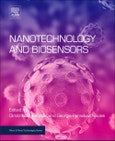Nanotechnology and Biosensors shows how nanotechnology is used to create affordable, mass-produced, portable, small sized biosensors to directly monitor environmental pollutants. In addition, it provides information on their integration into components and systems for mass market applications in food analysis, environmental monitoring and health diagnostics. Nanotechnology has led to a dramatic improvement in the performance, sensitivity and selectivity of biosensors. As metal-oxide and carbon nanostructures, gold and magnetite nanoparticles, and the integration of dendrimers in biosensors using nanotechnology have contributed greatly in making biosensors more effective and affordable on a mass-market level, this book presents a timely resource on the topic.
Please Note: This is an On Demand product, delivery may take up to 11 working days after payment has been received.
Table of Contents
1. Prototype biosensing devices: design and microfabrication based on nanotechnological tools for the rapid in the field detection of food toxicants and environmental pollutants2. Biosensors for intracellular and less invasive sensors based on nanostructured metal oxides
3. Carbon electrodes in electrochemical analysis of biomolecules and bioactive substances: roles of surface structures and chemical groups
4. Carbon based nanomaterials for electrochemical DNA sensing
5. Gold nanoparticle-based technologies in photothermal/photodynamic treatment: the challenges and prospects
6. Encapsulated Magnetite Nanoparticles: Preparation and Application as Contrast Agents for Magnetic Resonance Imaging
7. Metal nanomaterial-assisted aptasensors for emerging pollutants detection
8. Impedimetric aptamer biosensing employing nanomaterials
9. Metal-oxide nanostructures for energy harvesting and sensing
10. Electroanalytical bioplatforms based on carbon nanostructures as new tools for diagnosis
11. Dendrimers integrated biosensors for healthcare applications
12. Electrochemical DNA and aptasensors based on nanomaterials for medical diagnostics
Authors
Dimitrios P Nikolelis Laboratory of Environmental Chemistry, Department of Chemistry, University of Athens and Laboratory of Inorganic and Analytical Chemistry, School of Chemical Engineering, Department of Chemical Sciences, National Technical University of Athens, Greece. Dimitrios P. Nikolelis is Professor. of Analytical and Environmental Chemistry at the University of Athens, Greece. The co-ordinator of several Europe- and NATO-wide research projects focusing on biosensors and nanotechnology, and has also served as Editor-in-Chief of five peer-reviewed journals.Georgia-Paraskevi Nikoleli is based at the Laboratory of Inorganic & Analytical Chemistry, School of Chemical Engineering, University of Athens, Greece. Her research is in the area of nanotechnology, looking at multifunctional new materials and the production of processes and new devices. Georgia Paraskevi Nikoleli Laboratory of Inorganic and Analytical Chemistry, School of Chemical Engineering, University of Athens, Greece. Georgia-Paraskevi Nikoleli is based at the Laboratory of Inorganic & Analytical Chemistry, School of Chemical Engineering, University of Athens, Greece, where she also obtained the PhD. She is currently working as a lecturer in Technological Institute (TEI) of Athens, Greece. Her research is in the area of nanotechnology, looking at multifunctional new materials and the production of processes and new devices








